Bradford City
In 1895, a dispute over broken time payments led to rugby clubs from Lancashire and Yorkshire breaking away from the Rugby Football Union to form the Northern Rugby Union (which evolved new rules that would become Rugby League). At the time Bradford RFC, which drew its membership from the city's upper and middle classes was the leading side in the city while Manningham RFC, whose members were mainly from the working class, were a second-string team.
By the turn of the century, Manningham had fallen on hard times, recording a loss of £660 in the 1902-03 season. Across the Pennines, the professional Lancashire clubs playing the association game were thriving and following an Extraordinary General Meeting on 26 March 1903, it was decided to form a professional association team, to be called Bradford City, and play rugby and soccer on alternate weekends.
A delegation traveled to London on 25th May to apply for admission to the League, despite the fact that Bradford City had no players and had never played a game. The infant club was accepted with open arms and the delegation returned to Bradford in triumph. At the Belle Vue public house they celebrated what was described as ‘the greatest football scoop ever known’. City had joined the League without having played a single match. At the AGM five days later the decision to adopt football was ratified and the idea of playing rugby on alternate weekends was quietly dropped. Over the following years, several more struggling professional rugby teams in Yorkshire followed Manningham's example and switched codes.
For the first few months of their inaugural season, City wore the claret and amber hooped jerseys of the rugby team before their new vertically striped shirts were delivered. It is incidentally believed that the claret and amber colours, unique in the League, were those of the Prince of Wales Own (West Yorkshire) Regiment.
By the end of 1906, Bradford City were attracting an average of over 11,000 spectators while Bradford RFC's gates had fallen to 4-5,000, A proposal was put forward in April 1907 to merge the two clubs and play at the rugby club's far bigger Park Avenue stadium. With City on the brink of the First Division, there were clear advantages to a merged club playing in a larger stadium, not least of which was that they would no longer compete for paying spectators. Initially the proposal was rejected by Bradford's overwhelmingly middle-class membership who furthermore resolved to leave the Northern RU and rejoin the RFU. Bradford's chairman, Arthur Briggs, refused to accept the result and steamrollered the merger proposal through. It was then the turn of Bradford City's members to vote: there was fury at what many saw as an attempt by the wealthier rugby to co-opt everything that City had worked so hard to achieve and the proposal was thrown out by 1,031 votes to 487.
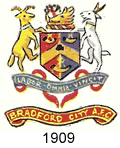 City won the Division Two championship in 1908 and gained promotion to Division One. In 1903 the team had adopted the crest of the borough of Bradford, and this featured on their shirts from 1909 until 1923 (making a final appearance in the 1933-34 season). In 1911 City finished fifth in Division One, their highest ever placing and won the FA Cup, beating the then powerful Newcastle United 1-0 in a replay. The distinctive, yoked shirts of the period became forever associated with this side and were to be revived on several occasions.
City won the Division Two championship in 1908 and gained promotion to Division One. In 1903 the team had adopted the crest of the borough of Bradford, and this featured on their shirts from 1909 until 1923 (making a final appearance in the 1933-34 season). In 1911 City finished fifth in Division One, their highest ever placing and won the FA Cup, beating the then powerful Newcastle United 1-0 in a replay. The distinctive, yoked shirts of the period became forever associated with this side and were to be revived on several occasions.
The nickname of "The Bantams" dates from 1909 after a horseshoe, their previous lucky charm, was lost and was the suggestion the daughter of Tom Fattorini, a club director and owner of the firm that made the second FA Cup which the club won in 1911.
There was to be no further glory, however, and City went into long term decline, dropping into Division Two in 1922 and then into Division Three (North) in 1927. Although the club returned to Division Two only two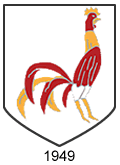 years later, it would be a temporary recovery and in 1937 The Bantams found themselves back in Division Three (North) where they would remain for 23 years before being relegated to Division Four in 1961.
years later, it would be a temporary recovery and in 1937 The Bantams found themselves back in Division Three (North) where they would remain for 23 years before being relegated to Division Four in 1961.
During the war years the club became known as "The Paraders" but the old nickname was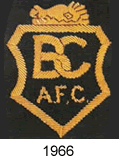 revived the following decade. According to The Paraders website, a bantam appeared on the players' shirts briefly in the early 1950s but we have not been able to confirm this.
revived the following decade. According to The Paraders website, a bantam appeared on the players' shirts briefly in the early 1950s but we have not been able to confirm this.
Throughout the early 1960s, City experimented with various combinations of claret and amber before settling on iconic striped shirts with black shorts in 1965. In 1966 a new crest, featuring the boar's head (taken from the civic coat of arms) was adopted but this did not appear on team shirts.
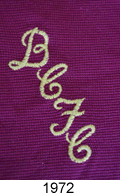 Further experimentation with playing strips followed in the 1970s, with first plain claret and then all-amber
Further experimentation with playing strips followed in the 1970s, with first plain claret and then all-amber 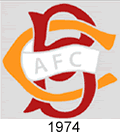 kits being worn, both being embroidered with a simple monogramme.
kits being worn, both being embroidered with a simple monogramme.
In 1974 a new official crest was designed with intertwined lettering and this appeared on the 1976-77 shirts. Aside from the 1977-78 season, the team now wore predominantly white strips with claret and amber trimmings. The Admiral strips worn between 1978 and 1981 had yet another new badge in a very 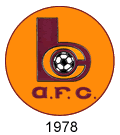 modernistic style embroidered on to them.
modernistic style embroidered on to them.
The early Eighties were a bleak period for the club, with Valley Parade in a state of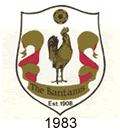 advanced disrepair and financial problems mounting. In December 1981 they were re-launched as "The Bantams" and over the following four years three new crests were introduced but, presumably to save costs, these were not embroidered on to the team shirts. The 1983 version included the wrong year for City's formation and was dropped after one year.
advanced disrepair and financial problems mounting. In December 1981 they were re-launched as "The Bantams" and over the following four years three new crests were introduced but, presumably to save costs, these were not embroidered on to the team shirts. The 1983 version included the wrong year for City's formation and was dropped after one year.
In the summer of 1983, despite having been promoted back into Division Three, the club faced bankruptcy. A pre-season photograph shows the players wearing an all-white kit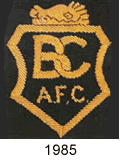 but when the 1983-84 season started, the team turned out in a claret and amber kit designed by Patrick for Motherwell FC. The following season an all-white kit (favoured by manager Trevor Cherry, a former Leeds player) was adopted.
but when the 1983-84 season started, the team turned out in a claret and amber kit designed by Patrick for Motherwell FC. The following season an all-white kit (favoured by manager Trevor Cherry, a former Leeds player) was adopted.
In 1985 things were looking up for the club and the boar's head was re-introduced on a strip that featured the familiar stripes (albeit with a very peculiar shade of claret). On 11 May 1985 fans were celebrating promotion back to Division Two when tragedy struck. The wooden Main Stand was engulfed in flames and fifty-six fans died in the inferno. The horror concentrated the minds of football authorities on safety and throughout the League old stands were hastily closed and demolished while, following the Popplewell Enquiry, the construction of new wooden structures at sports grounds was prohibited. The town rallied to support the club who enjoyed five seasons in Division Two before being relegated once again. Ever since that disaster, black has featured in the home shirts as a mark of respect to those who died.
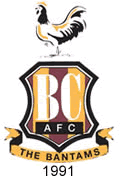 In 1991 the boar's head was retired for the second time and new badge introduced with the bantam cock again in evidence, although it now looked more like a full-sized cockerel than a fighting bantam.
In 1991 the boar's head was retired for the second time and new badge introduced with the bantam cock again in evidence, although it now looked more like a full-sized cockerel than a fighting bantam.
In the late Nineties, City climbed up from Nationwide Division Two (the old third Division) all the way to the Premier Division where they spent two unforgettable seasons 1999-2001. In 2004 the Bantams marked their centenary and briefly wore a replica of their original claret and amber strip but the deal with the manufacturer, Diadora, collapsed and a more modern kit was adopted.
